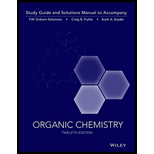
Concept explainers
Interpretation:
Accomplishment of each of the given transformations is to be shown.
Concept introduction:
Swern Oxidation converts primary and secondary alcohols into
Reduction of
Chromic acid oxidation: Oxidation of primary alcohols to aldehydes and use of hydronium (aqueous medium) to further oxidize the aldehydes to
Pyridinium Chlorochromate (PPC): PPC is formed from pyridine, hydrochloric acid and chromium oxide. This allows for controlled oxidation since this reaction takes place in anhydrous conditions.
Potassium Permanganate: Potassium permanganate is a strong oxidizing agent. It converts the primary alcohols and aldehydes to their corresponding carboxylic acids. It converts secondary alcohols to ketones. This is not a controlled reaction since the reaction occurs in aqueous medium.
When an oxidation takes place, the hydrogen atom attached to the oxygen atom is removed to form aldehydes from alcohols, or to form carboxylic acids from aldehydes. Compounds with no hydrogen attached to oxygen cannot be oxidized using Swern oxidation. Examples of such compounds are tertiary alcohols and ethers.
Want to see the full answer?
Check out a sample textbook solution
Chapter 12 Solutions
Organic Chemistry, 12e Study Guide/Student Solutions Manual
- Predict the major organic product of each of the following reactions or provide the reagent needed to complete each transformation.arrow_forwardThe following compound, 2-hydroxycycloheptatrienone, does not give all the usual carbonyl group reactions. (i) Explain this apparent anomaly. Furthermore, explain the significant difference between the relative stability of this compound and its 3- and 4-hydroxy isomers. (ii) What would you expect to be the influence of adding (a) a nitro group as a substituent on the 7-membered ring or (b) an alkyl group, on the degree of aromaticity of the above compound. (iii) Based on your understanding of the hydrogen bonding concept, which isomer would you expect to have a higher m.p, (assuming they are both solids) between 2- and 4- hydroxycycloheptatrienone? Explain your choice.arrow_forwardPRACTICE PROBLEM 8.20 Specify the alkene and reagents needed to synthesize each of the following diols. OH HO- (a) (b) (c) HO. н он HO (racemic) (racemic)arrow_forward
- Show how you would convert hex-1-ene to each of the following compounds. You may use any additional reagents andsolvents you need.( (b) 1-methoxyhexanearrow_forwardUsing hex-1-ene as your starting material, show how you would synthesize the following compounds. (Once you haveshown how to synthesize a compound, you may use it as the starting material in any later parts of this problem.)(a) 1,2-dibromohexanearrow_forwardProvide the reagents and solvents (where appropriate) needed to bring about the following transformations. (a) CI (b)arrow_forward
- Predict the major products of the following reactions, including stereochemistry where appropriate. (a) potassium tert-butoxide + methyl iodide (b) sodium methoxide + tert-butyl iodidearrow_forwardplease answer all questions.arrow_forwardIdentify the major product(s) of the following reactions. Include stereochemistry. (a) (b) (c) Br NaOEt NaOEt NaOEtarrow_forward
- 2. (a) (b) OUTLINE, using suitable mechanisms, how each of the following conversions is achieved. In each case, you should indicate the reagents to be used and show ALL intermediate compounds. Each arrow may represent one or more than one step. CH3CH₂Br (C6H5)3P CHCH3 H CH3 ——-||- H- (C₂H₂)₂N- H H CH,CH,CHO -CHO H₂C CH3 CHCH3arrow_forwardAssign E or Z stereochemistry to each of the following alkenes, and convert each drawing into a skeletal structure (red = 0, yellow-green = Cl). (a) (b)arrow_forward(a) (b) (c) Suggest a synthesis of the following alkene (A) using a Wittig reaction strategy. Draw the starting material(s), key reagent and a full reaction mechanism including an explanation of the observed geometry. Which of the following (B) and (C) will favour the enol form? Briefly explain your reasoning. Predict the product(s) and provide a mechanism for each of the following transformations: (i) (ii) OMe OMe Base OEt NaOEtarrow_forward
 ChemistryChemistryISBN:9781305957404Author:Steven S. Zumdahl, Susan A. Zumdahl, Donald J. DeCostePublisher:Cengage Learning
ChemistryChemistryISBN:9781305957404Author:Steven S. Zumdahl, Susan A. Zumdahl, Donald J. DeCostePublisher:Cengage Learning ChemistryChemistryISBN:9781259911156Author:Raymond Chang Dr., Jason Overby ProfessorPublisher:McGraw-Hill Education
ChemistryChemistryISBN:9781259911156Author:Raymond Chang Dr., Jason Overby ProfessorPublisher:McGraw-Hill Education Principles of Instrumental AnalysisChemistryISBN:9781305577213Author:Douglas A. Skoog, F. James Holler, Stanley R. CrouchPublisher:Cengage Learning
Principles of Instrumental AnalysisChemistryISBN:9781305577213Author:Douglas A. Skoog, F. James Holler, Stanley R. CrouchPublisher:Cengage Learning Organic ChemistryChemistryISBN:9780078021558Author:Janice Gorzynski Smith Dr.Publisher:McGraw-Hill Education
Organic ChemistryChemistryISBN:9780078021558Author:Janice Gorzynski Smith Dr.Publisher:McGraw-Hill Education Chemistry: Principles and ReactionsChemistryISBN:9781305079373Author:William L. Masterton, Cecile N. HurleyPublisher:Cengage Learning
Chemistry: Principles and ReactionsChemistryISBN:9781305079373Author:William L. Masterton, Cecile N. HurleyPublisher:Cengage Learning Elementary Principles of Chemical Processes, Bind...ChemistryISBN:9781118431221Author:Richard M. Felder, Ronald W. Rousseau, Lisa G. BullardPublisher:WILEY
Elementary Principles of Chemical Processes, Bind...ChemistryISBN:9781118431221Author:Richard M. Felder, Ronald W. Rousseau, Lisa G. BullardPublisher:WILEY





